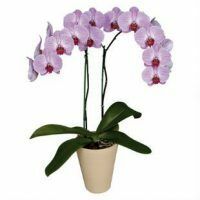
Flowers - a beautiful decoration of any interior. But what if your apartment does not have enough light for their full growth? The answer is simple: it is necessary to plant unpretentious houseplants. In general, these are plants that grow naturally in shady or shaded places in natural conditions. We offer you titles, a brief description and photos of the most popular room shade-loving plants.
- Flowering
- Spatifilum
- Gardenia
- Saintpaulia
- Vrieziya
- Anthurium Begonia
- clivia
- Calathea Krokata
- Miltonia
- streptokarpusy
- Azalea
- angraecum
- ampelnye
- Ivy
- zelenolistnyh Syngonium
- rhoicissus rhombic
- epipremnum
- peperomiya
- Tradescantia
- Creeping kalliziya
- Scindapsus
- Palm and coarse sizes
- Ficuses
- Hamedoraea
- Rapis
- Dracena
- Cordillina
- Monstera
- Leafy
- Fittonia
- Nephrolepis
- Fatshedera lise
- Fatsia Japanese
- Adiantum
- Philodendron
- Kalatea
- Maranta
- Aukuba
- Codium
Flowering
Among the shade-loving plants are many beautiful flowering plants. So you have the opportunity to decorate with luxurious colors and northern and shaded windows. It is only necessary to create optimal conditions for plants for lush flowering and active growth.
to table of contents ^Spathiphyllum
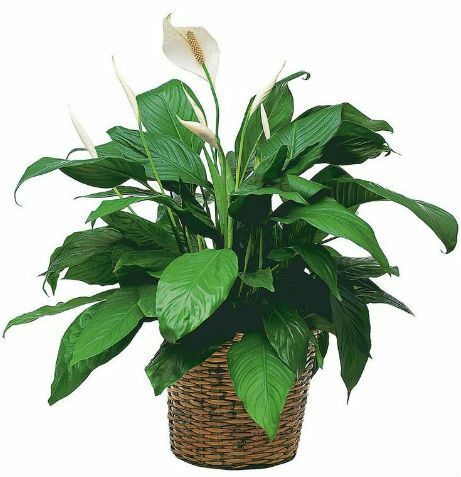 Spathiphyllum is a beautiful, beloved by many growers, a shade-tolerant indoor flower. He perfectly feels on the northern window, where his leaves get a rich green hue and elongated shape. He likes frequent spraying, and once a month - a shower.
Spathiphyllum is a beautiful, beloved by many growers, a shade-tolerant indoor flower. He perfectly feels on the northern window, where his leaves get a rich green hue and elongated shape. He likes frequent spraying, and once a month - a shower.
Gardenia
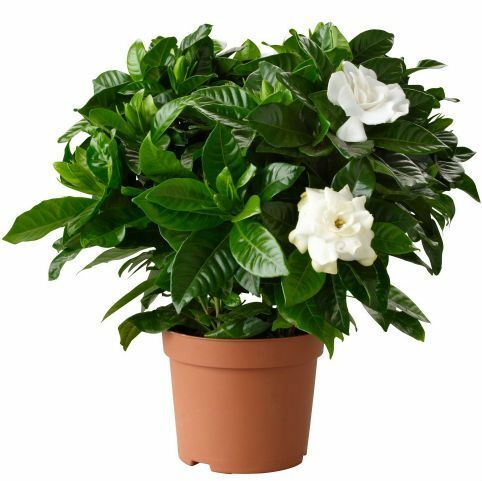 Gardenia - a real find for lovers of flowering houseplants. With good humidity, comfortable temperature( from +16 to 24ºC), this beauty will please you with its luxurious colors. Just do not forget to remove wilted buds in time.
Gardenia - a real find for lovers of flowering houseplants. With good humidity, comfortable temperature( from +16 to 24ºC), this beauty will please you with its luxurious colors. Just do not forget to remove wilted buds in time.
Senpia
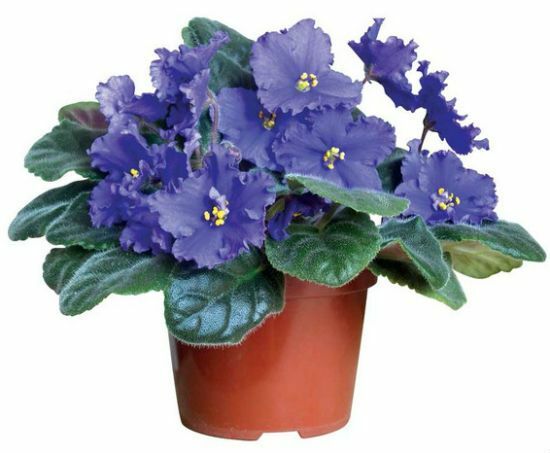 Senpolia( Uzambara violet) is one of the most widespread flowering indoor herbaceous plants. It perfectly develops and beautifully blooms in partial shade, with sufficient humidity and comfortable temperature( from +20 to +24 ° C).
Senpolia( Uzambara violet) is one of the most widespread flowering indoor herbaceous plants. It perfectly develops and beautifully blooms in partial shade, with sufficient humidity and comfortable temperature( from +20 to +24 ° C).
Vreezia
 Vriesia is an unusually beautiful indoor flower, remembered for its bright arrow. However, when growing it, you need to monitor the air temperature( not below +18 and not above +27 ° C) and the presence of water in its outlet.
Vriesia is an unusually beautiful indoor flower, remembered for its bright arrow. However, when growing it, you need to monitor the air temperature( not below +18 and not above +27 ° C) and the presence of water in its outlet.
Anthurium
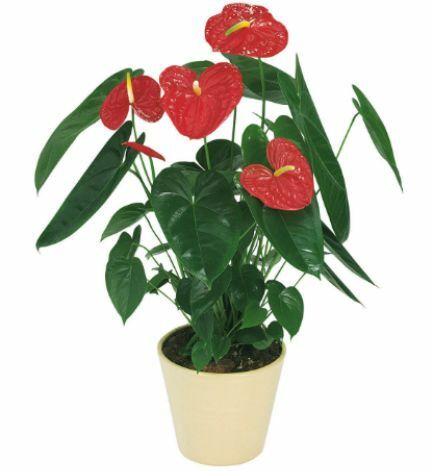 Anthurium is a rather capricious, but very beautiful flower, many species of which are intended only for heated greenhouses. When working with a plant, you need to be as careful as possible, since it contains substances that irritate the mucous membrane.
Anthurium is a rather capricious, but very beautiful flower, many species of which are intended only for heated greenhouses. When working with a plant, you need to be as careful as possible, since it contains substances that irritate the mucous membrane.
Begonia
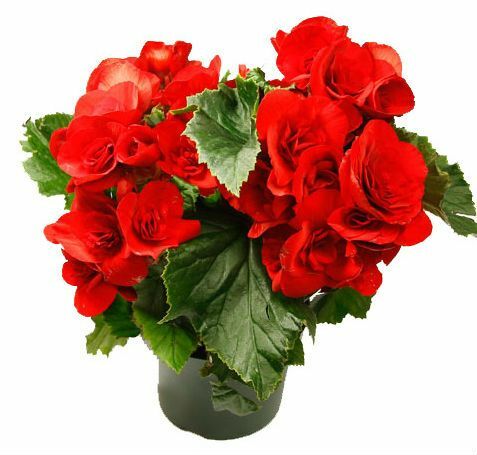 Begonia is one of the most beautiful shade plants, whose beautiful large bright flowers serve to decorate any interior in summer and winter. There are about 2000 kinds of decorative-deciduous and decorative-flowering begonias. And they all prefer partial shade and moderate watering.
Begonia is one of the most beautiful shade plants, whose beautiful large bright flowers serve to decorate any interior in summer and winter. There are about 2000 kinds of decorative-deciduous and decorative-flowering begonias. And they all prefer partial shade and moderate watering.
Cleia
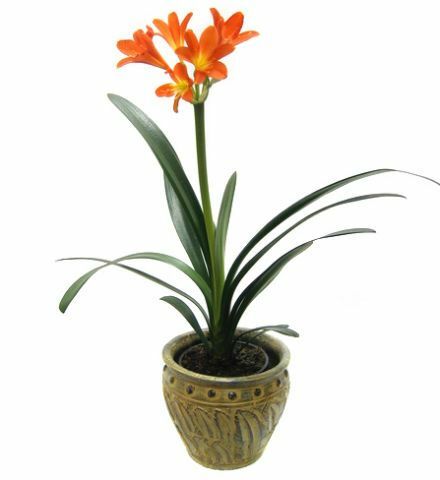 The shade pleasures delight the flower growers with unusual umbelliform inflorescences located on tall peduncles. However, for abundant flowering, it needs good watering, light semi-shade and fertile soil.
The shade pleasures delight the flower growers with unusual umbelliform inflorescences located on tall peduncles. However, for abundant flowering, it needs good watering, light semi-shade and fertile soil.
Kalatea Crocata
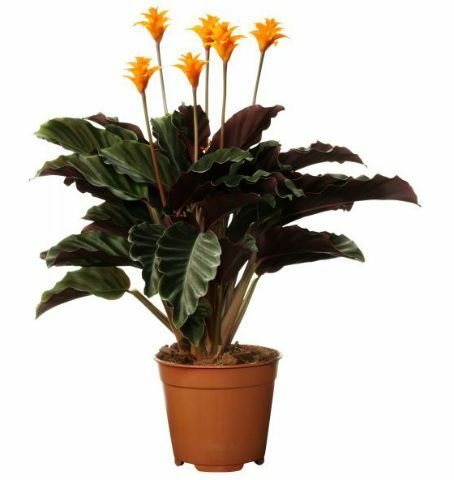 This representative of the family of maranthives is grown for her beautiful leaves of unusual colors: in specks, dash, dark and light green. Kalatea Crocata does not tolerate temperature fluctuations and dry air. Excellent grows in a closed flower window.
This representative of the family of maranthives is grown for her beautiful leaves of unusual colors: in specks, dash, dark and light green. Kalatea Crocata does not tolerate temperature fluctuations and dry air. Excellent grows in a closed flower window.
Miltonia
 For their lovely flowers, wide open and pansy-like, the Miltonia orchid is called - "pansies".Likes partial shade and good humidity. He is afraid of drafts. A sign of the correct location of the plant is the pinkish shade of its leaves.
For their lovely flowers, wide open and pansy-like, the Miltonia orchid is called - "pansies".Likes partial shade and good humidity. He is afraid of drafts. A sign of the correct location of the plant is the pinkish shade of its leaves.
Streptocarpus
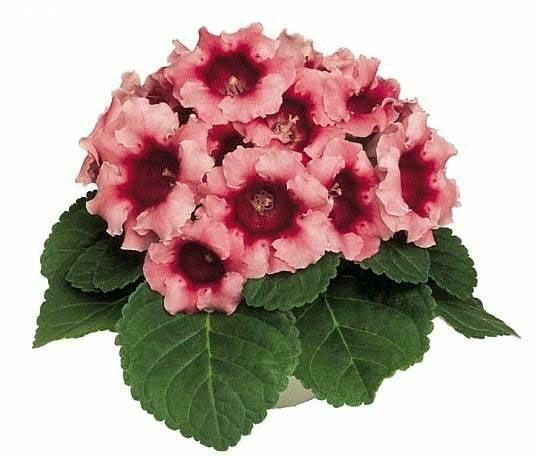 Streptocarpus, with its gentle, bell-like flowers -a real find for the florists. He is unpretentious in his care, suffers a penumbra, blooms for a long time( up to six months) and easily reproduces any of his parts.
Streptocarpus, with its gentle, bell-like flowers -a real find for the florists. He is unpretentious in his care, suffers a penumbra, blooms for a long time( up to six months) and easily reproduces any of his parts.
Azalea
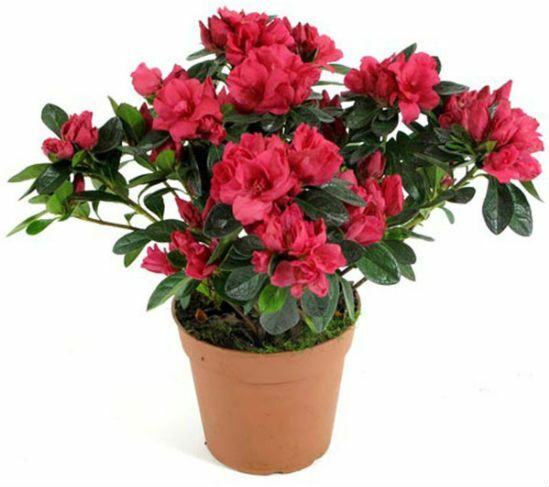 Azalea( rhododendron) is rightly recognized as one of the most beautiful and bright flowering indoor plants. In conditions of high humidity, with regular spraying and observing the temperature regime( from +12 to +20 ° C), she will enjoy a luxurious cap of amazing colors in the winter cold.
Azalea( rhododendron) is rightly recognized as one of the most beautiful and bright flowering indoor plants. In conditions of high humidity, with regular spraying and observing the temperature regime( from +12 to +20 ° C), she will enjoy a luxurious cap of amazing colors in the winter cold.
Angrecom
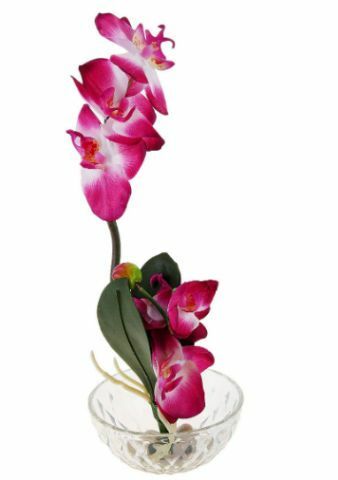 Angrecomum, like all orchids, is a very delicate and whimsical tropical flower. But it grows well with abundant moisturizing and regular spraying with soft, warm water in the shallow penumbra or with sufficient artificial light.
Angrecomum, like all orchids, is a very delicate and whimsical tropical flower. But it grows well with abundant moisturizing and regular spraying with soft, warm water in the shallow penumbra or with sufficient artificial light.
Ampel
Ample room shade-loving plants are an excellent decor of the rooms, especially if you need to decorate the walls. They grow them in hanging pots, pots, vases and baskets.
to table of contents ^Ivy
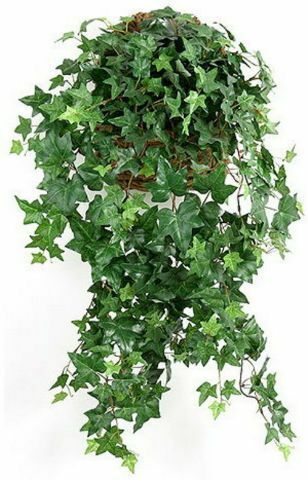 Ivy is one of the popular ampel plants. It absolutely does not tolerate direct sunlight, changes in the light source and does not like temperature changes. Shadow-tolerant, but loves soft diffused light.
Ivy is one of the popular ampel plants. It absolutely does not tolerate direct sunlight, changes in the light source and does not like temperature changes. Shadow-tolerant, but loves soft diffused light.
Green-leaved syngonium
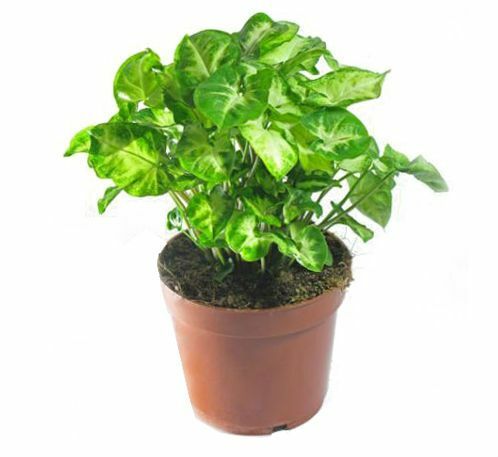 Green-leaved syngonyum - very beautiful, original liana with succulent leaves on long petioles. The leaves of the plant, closing, form a solid green cascade, which will decorate any interior. The main thing is to avoid excessive dryness of the air.
Green-leaved syngonyum - very beautiful, original liana with succulent leaves on long petioles. The leaves of the plant, closing, form a solid green cascade, which will decorate any interior. The main thing is to avoid excessive dryness of the air.
Roicissium rhombic
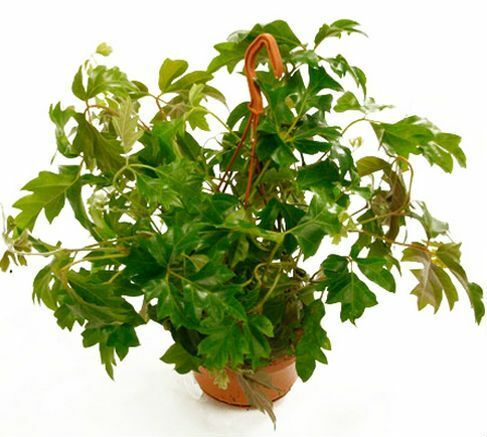 Roicicidal rhombus is perfect for vertical landscaping of large rooms. But remember that this decorative-hardwood vine from the family of grape requires regular pruning and systematic spraying.
Roicicidal rhombus is perfect for vertical landscaping of large rooms. But remember that this decorative-hardwood vine from the family of grape requires regular pruning and systematic spraying.
Epipremnum
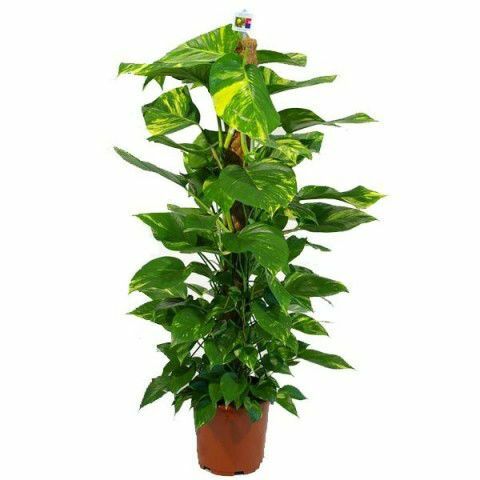 Epipremnum - unpretentious, very easy to grow tropical liana. It grows very quickly( over a year - more than a meter) and beautifully curls over a decorative, moss-covered, special support. Blossoms only in natural natural conditions.
Epipremnum - unpretentious, very easy to grow tropical liana. It grows very quickly( over a year - more than a meter) and beautifully curls over a decorative, moss-covered, special support. Blossoms only in natural natural conditions.
Peperomy
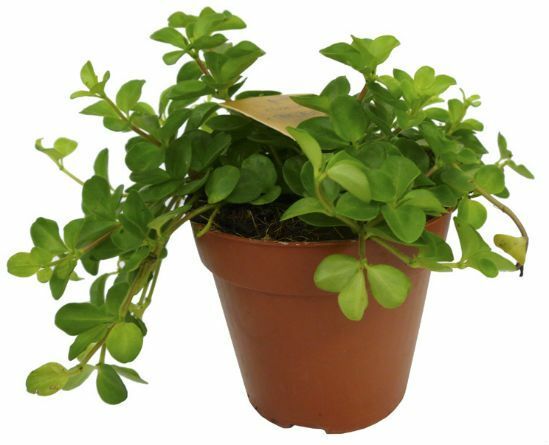 Peperomy is a perennial tropical evergreen herbaceous plant from the southern regions of India and America. In nature it grows on the trunks of trees, and in the room it grows well in the light penumbra. True, in winter, in order not to lose color, requires more bright lighting.
Peperomy is a perennial tropical evergreen herbaceous plant from the southern regions of India and America. In nature it grows on the trunks of trees, and in the room it grows well in the light penumbra. True, in winter, in order not to lose color, requires more bright lighting.
Tradescantia
 A native of the Americas, today Tradescantia is undeservedly forgotten, although not so long ago it could be seen in any public place. The advantages of this perennial room herbaceous plant in its absolute unpretentiousness. It grows well in the shade. The main thing - a sufficient amount of moisture.
A native of the Americas, today Tradescantia is undeservedly forgotten, although not so long ago it could be seen in any public place. The advantages of this perennial room herbaceous plant in its absolute unpretentiousness. It grows well in the shade. The main thing - a sufficient amount of moisture.
Creeping calligraphy
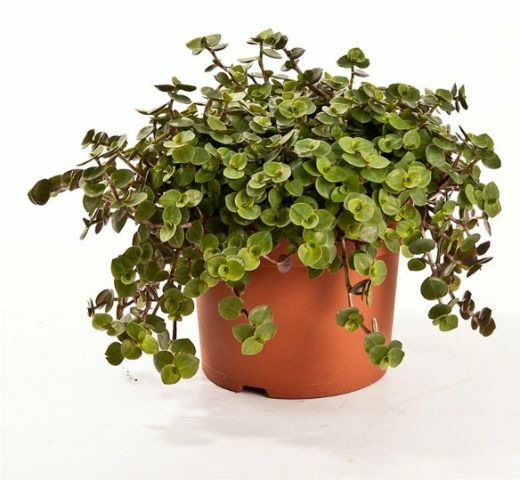 Creeping calligraphy grows quickly and creates a beautiful green carpet that pleases the eye nicely. It is only necessary to make sure that the soil in which the calligraphy grows does not dry up, and there is plenty of air and space around the plant. He likes "walks" on the balcony or terrace.
Creeping calligraphy grows quickly and creates a beautiful green carpet that pleases the eye nicely. It is only necessary to make sure that the soil in which the calligraphy grows does not dry up, and there is plenty of air and space around the plant. He likes "walks" on the balcony or terrace.
Scindapsus
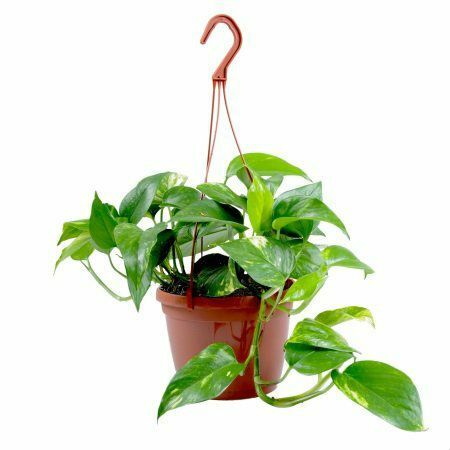 Scindapsus - unpretentious tropical liana with original leaves, painted in yellow and white stains. This fast-growing plant looks great against the background of greenery of other flowers, loves high humidity, partial shade, and from spring to autumn - abundant watering.
Scindapsus - unpretentious tropical liana with original leaves, painted in yellow and white stains. This fast-growing plant looks great against the background of greenery of other flowers, loves high humidity, partial shade, and from spring to autumn - abundant watering.
Palm and large-sized
Shade-like palm plants and large-sized plants are widely used in ornamental floriculture. They look great in isolation and decorate the decor of large spacious rooms, adding a touch of exoticism.
to the table of contents ^Ficuses
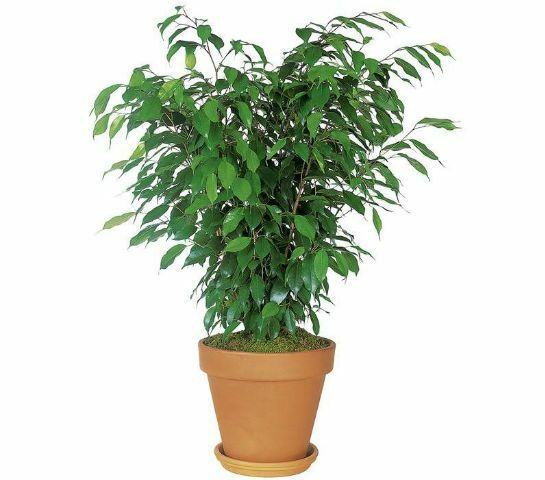 Ficuses are popular treelike fast-growing beautiful shade-loving plants. They look good in residential and office buildings, and in winter gardens. Ficuses are very fond of partial shade and abundance of moisture.
Ficuses are popular treelike fast-growing beautiful shade-loving plants. They look good in residential and office buildings, and in winter gardens. Ficuses are very fond of partial shade and abundance of moisture.
Hamedoraea
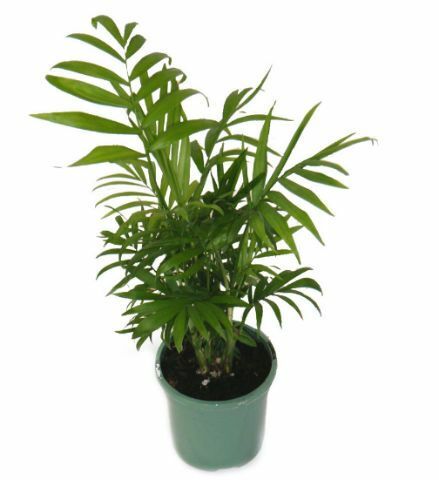 Hamedorei is a slow-growing shade-tolerant palm tree. Another name is a bamboo palm. It is important to spray the leaves of this beauty often, wipe them with dust with a soft damp cloth, protect from direct sunlight, and wash every second week under a warm shower.
Hamedorei is a slow-growing shade-tolerant palm tree. Another name is a bamboo palm. It is important to spray the leaves of this beauty often, wipe them with dust with a soft damp cloth, protect from direct sunlight, and wash every second week under a warm shower.
Rapis
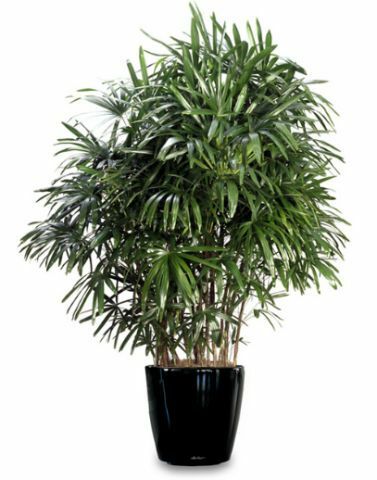 Rapis is a slow-growing decorative palm tree that not only decorates the interior, but alsoit cleans the air of pollutants. Rapis loves soft scattered light, abundant in summer( every 3 days), and in winter a moderate( once every 10 days) watering, walks and regular rubbing of leaves. It is also important to cut off the dried parts of the plant in time.
Rapis is a slow-growing decorative palm tree that not only decorates the interior, but alsoit cleans the air of pollutants. Rapis loves soft scattered light, abundant in summer( every 3 days), and in winter a moderate( once every 10 days) watering, walks and regular rubbing of leaves. It is also important to cut off the dried parts of the plant in time.
Dracaena
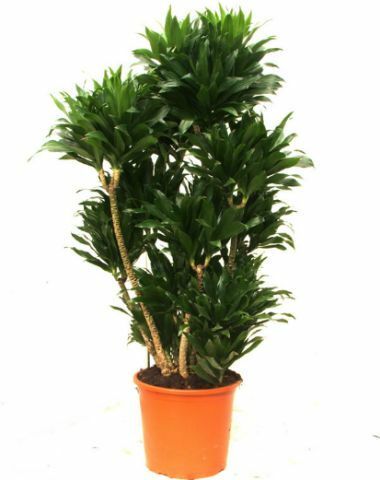 Dracaena is a tree-like ornamental houseplant, very similar to a palm tree. Its other name is the "dragon tree", which Dracaena acquired thanks to its unusual red juice. Very fond of moisture, moderate temperature and partial shade.
Dracaena is a tree-like ornamental houseplant, very similar to a palm tree. Its other name is the "dragon tree", which Dracaena acquired thanks to its unusual red juice. Very fond of moisture, moderate temperature and partial shade.
Cordilina
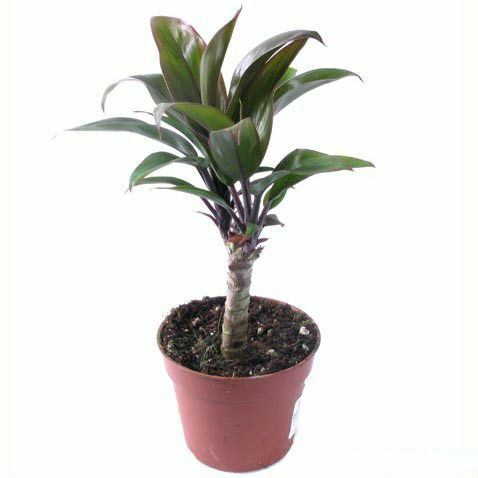 Cordilina is a tree-like shade-loving plant of the Drachen family. For good growth and beautiful appearance, the cordillina needs regular watering with soft water, diffuse light, and in winter in additional lighting.
Cordilina is a tree-like shade-loving plant of the Drachen family. For good growth and beautiful appearance, the cordillina needs regular watering with soft water, diffuse light, and in winter in additional lighting.
Monstera
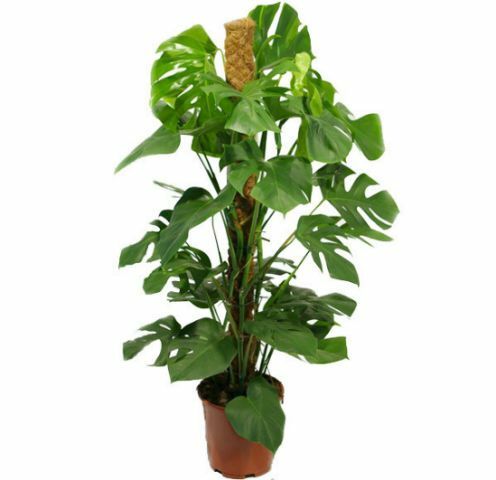 Monstera is one of the finest room vines. This tropical large-sized plant is very popular in homes and institutions with limited light. Under favorable conditions - moderate temperature, regular spraying, protection from direct sunlight, it can grow up to 3-4 m in height.
Monstera is one of the finest room vines. This tropical large-sized plant is very popular in homes and institutions with limited light. Under favorable conditions - moderate temperature, regular spraying, protection from direct sunlight, it can grow up to 3-4 m in height.
Hardwood
Decorative-deciduous shade-loving houseplants are natives of the subtropics and tropics. They are grown for their effective leaves. These non-flowering plants are not whimsical to light and can decorate the interior of rooms with windows facing north.
to the table of contents ^Fittonia
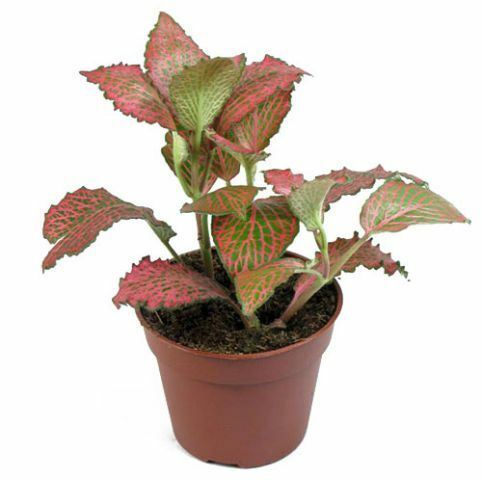 Fitton florists are bred because of its beautiful leaves. However, in order to ensure that their color does not turn pale, the plant needs penumbra, since fittonia does not stand either bright sun or full shadow. But in winter it needs additional lighting.
Fitton florists are bred because of its beautiful leaves. However, in order to ensure that their color does not turn pale, the plant needs penumbra, since fittonia does not stand either bright sun or full shadow. But in winter it needs additional lighting.
Nephrolepis
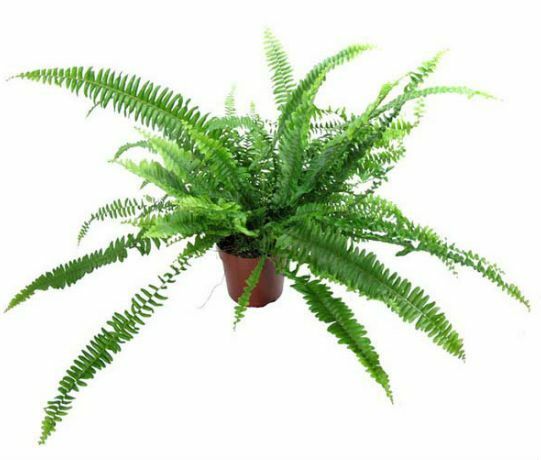 Nephrolepis is a vivid representative of ferns with growing stems and small green leaves. It grows beautifully in the penumbra, but does not like too dark places and the direct rays of the sun fall on the leaves. It needs constant spraying with soft warm water.
Nephrolepis is a vivid representative of ferns with growing stems and small green leaves. It grows beautifully in the penumbra, but does not like too dark places and the direct rays of the sun fall on the leaves. It needs constant spraying with soft warm water.
Fatschedera Lisa
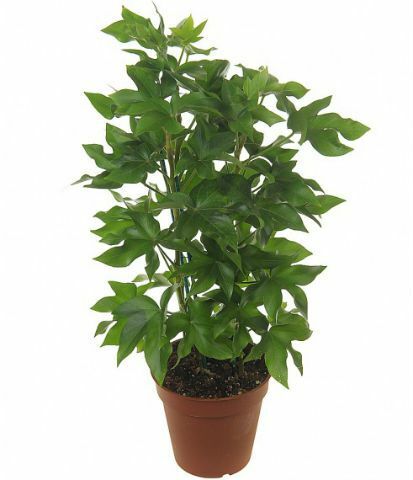 Fatschedera Lize is an original hybrid of ivy and Japanese fatsia. This deciduous shade-tolerant houseplant is perfect for the hallway. It can be planted at the entrance door and the north window. The main thing - do not pour and take out to fresh air in the summer.
Fatschedera Lize is an original hybrid of ivy and Japanese fatsia. This deciduous shade-tolerant houseplant is perfect for the hallway. It can be planted at the entrance door and the north window. The main thing - do not pour and take out to fresh air in the summer.
Fatsia Japanese
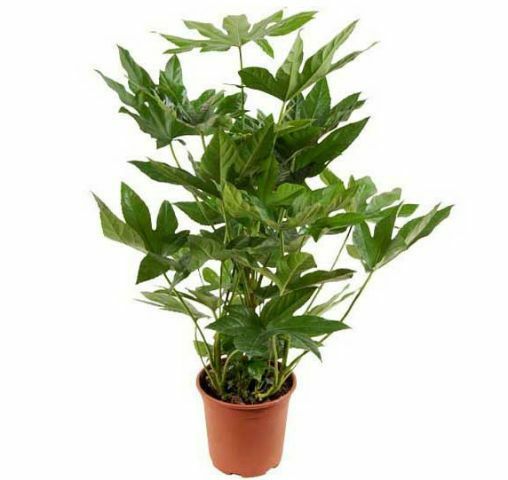 Thanks to its beautiful crown Japanese fatsia is widely used for decorating interiors. She is not very capricious, grows fast and takes a penumbra, but prefers coolness and fresh air. Also, for a comfortable development, it needs a lot of free space.
Thanks to its beautiful crown Japanese fatsia is widely used for decorating interiors. She is not very capricious, grows fast and takes a penumbra, but prefers coolness and fresh air. Also, for a comfortable development, it needs a lot of free space.
The Adianum
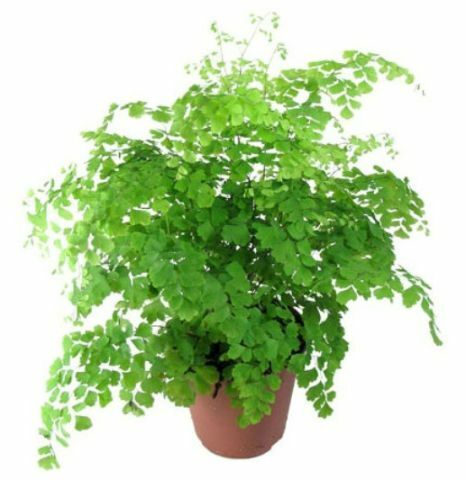 The Adiantum is the most refined and gentle representative of ferns. Its beautiful leaves are widely used for decorating bouquets and decorate any interior. However, they require protection from the bright sun. Therefore, the penumbra and the northern windows are ideal for an idiot.
The Adiantum is the most refined and gentle representative of ferns. Its beautiful leaves are widely used for decorating bouquets and decorate any interior. However, they require protection from the bright sun. Therefore, the penumbra and the northern windows are ideal for an idiot.
Philodendron
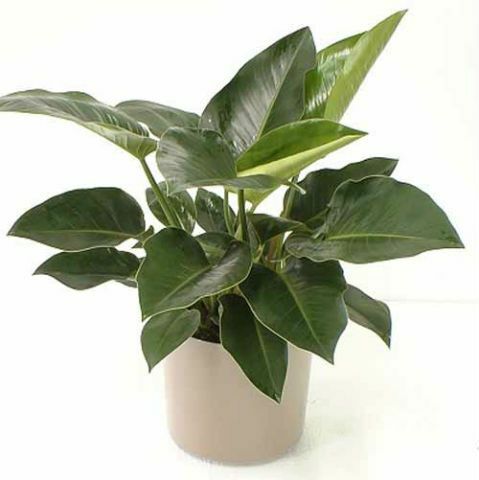 Philodendrons are beautiful creeping liana with semi-grassy woody branches and long air roots. This is one of the most shade-tolerant and unpretentious lianas suitable for growing in suspended flowerpots. It does not tolerate drafts, temperature changes, dryness of soil and air.
Philodendrons are beautiful creeping liana with semi-grassy woody branches and long air roots. This is one of the most shade-tolerant and unpretentious lianas suitable for growing in suspended flowerpots. It does not tolerate drafts, temperature changes, dryness of soil and air.
Kalatea
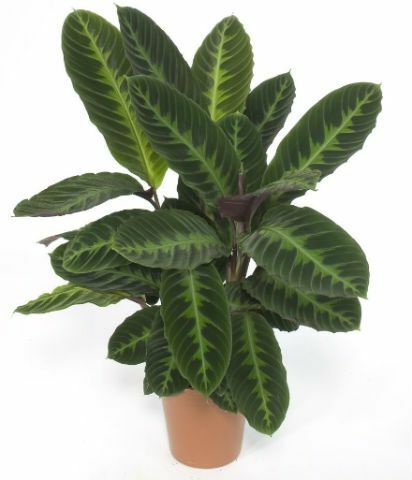 Kalatea is an excellent representative of the family of maranthives, whose main decoration is large leaves of the original color, which are added overnight. Kalatea is quite capricious in care. Best of all, it grows 2 m from the west window, on a pallet of wet pebbles, in the absence of drafts and temperature changes.
Kalatea is an excellent representative of the family of maranthives, whose main decoration is large leaves of the original color, which are added overnight. Kalatea is quite capricious in care. Best of all, it grows 2 m from the west window, on a pallet of wet pebbles, in the absence of drafts and temperature changes.
Marantha
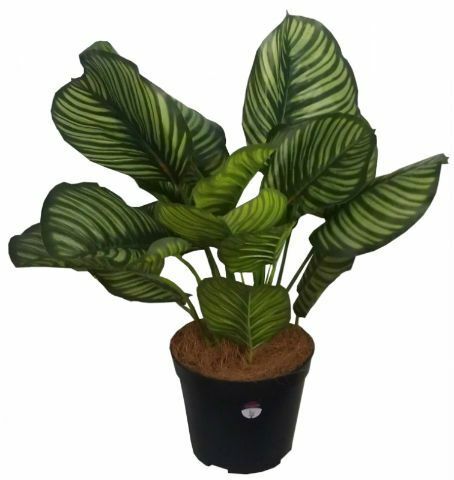 Marantha, with its original oval leaves, creates a unique decorative effect, which attracts many florists. True, they have to try to make sure that the arrowroot feels comfortable, and its leaves look attractive - often( every 3-4 days) watered and every day sprinkled with exceptionally constant water, protected from temperature drops, severe shade and bright light.
Marantha, with its original oval leaves, creates a unique decorative effect, which attracts many florists. True, they have to try to make sure that the arrowroot feels comfortable, and its leaves look attractive - often( every 3-4 days) watered and every day sprinkled with exceptionally constant water, protected from temperature drops, severe shade and bright light.
Aukuba
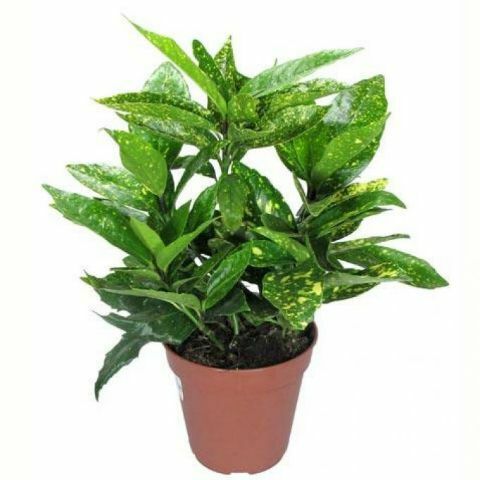 An inhabitant of subtropical forests, the aukuba refers to tree-like shade-loving plants. She is very shady and more afraid of excess of light than his lack. It is also important for akuba moderate air temperature( not above +20 ° C).Work with her carefully, because she is poisonous.
An inhabitant of subtropical forests, the aukuba refers to tree-like shade-loving plants. She is very shady and more afraid of excess of light than his lack. It is also important for akuba moderate air temperature( not above +20 ° C).Work with her carefully, because she is poisonous.
Codium
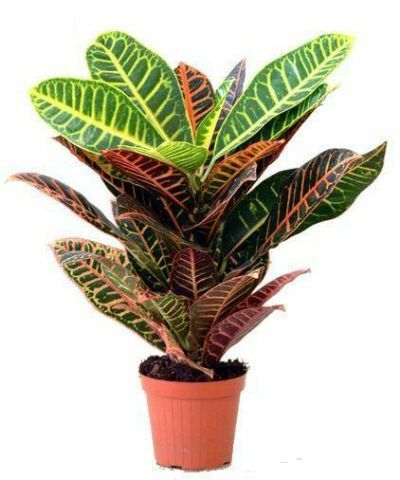 Cody( croton) is a beautiful house plant of the euphorbia family, valuable for its luxurious coloration of the leaves. It needs very good watering, drainage and constant spraying. It is important to spray the plant in the shade, since sunburn may appear on the leaves after sunburn.
Cody( croton) is a beautiful house plant of the euphorbia family, valuable for its luxurious coloration of the leaves. It needs very good watering, drainage and constant spraying. It is important to spray the plant in the shade, since sunburn may appear on the leaves after sunburn.
